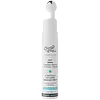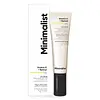What's inside
What's inside
 Key Ingredients
Key Ingredients

 Benefits
Benefits

 Concerns
Concerns

 Ingredients Side-by-side
Ingredients Side-by-side

Water
Skin ConditioningStearic Acid
CleansingPropanediol
SolventCoco-Caprylate
EmollientLactobacillus Ferment Lysate
Skin ConditioningCamellia Sinensis Leaf Extract
AntimicrobialPunica Granatum Extract
AstringentCaffeine
Skin ConditioningChenopodium Quinoa Seed Extract
Skin ConditioningGlyceryl Stearate
EmollientCetyl Alcohol
EmollientCetearyl Alcohol
EmollientBetaine
HumectantButyrospermum Parkii Butter
Skin ConditioningOlea Europaea Fruit Oil
MaskingPrunus Amygdalus Dulcis Protein
Skin ConditioningPhenoxyethanol
PreservativeAmmonium Acryloyldimethyltaurate/Vp Copolymer
Allantoin
Skin ConditioningTrisodium Ethylenediamine Disuccinate
Tocopheryl Acetate
AntioxidantSodium Hyaluronate
HumectantOryza Sativa Cera
Skin ConditioningHydrolyzed Amorphophallus Konjac Root
HumectantPhospholipids
Skin ConditioningSphingolipids
EmollientDisodium EDTA
Water, Stearic Acid, Propanediol, Coco-Caprylate, Lactobacillus Ferment Lysate, Camellia Sinensis Leaf Extract, Punica Granatum Extract, Caffeine, Chenopodium Quinoa Seed Extract, Glyceryl Stearate, Cetyl Alcohol, Cetearyl Alcohol, Betaine, Butyrospermum Parkii Butter, Olea Europaea Fruit Oil, Prunus Amygdalus Dulcis Protein, Phenoxyethanol, Ammonium Acryloyldimethyltaurate/Vp Copolymer, Allantoin, Trisodium Ethylenediamine Disuccinate, Tocopheryl Acetate, Sodium Hyaluronate, Oryza Sativa Cera, Hydrolyzed Amorphophallus Konjac Root, Phospholipids, Sphingolipids, Disodium EDTA
Water
Skin ConditioningGlycerin
HumectantNiacinamide
SmoothingDimethicone
EmollientPropanediol
SolventCaffeine
Skin ConditioningDicaprylyl Carbonate
EmollientBrassica Glycerides
EmollientDiisopropyl Sebacate
EmollientMaltodextrin
AbsorbentGlyceryl Glucoside
HumectantBehenyl Alcohol
EmollientButylene Glycol
HumectantPhytonadione Epoxide
AstringentPrunus Amygdalus Dulcis Oil
Skin ConditioningHydroxyethylcellulose
Emulsion StabilisingPentylene Glycol
Skin ConditioningHydrolyzed Sodium Hyaluronate
Skin ConditioningZerumbone
Skin ConditioningN-Hydroxysuccinimide
Skin ConditioningDipeptide-2
Skin ConditioningSteareth-20
CleansingChrysin
Skin ConditioningPalmitoyl Tetrapeptide-7
Skin ConditioningXanthan Gum
EmulsifyingRetinal
Skin ConditioningSodium Hyaluronate
HumectantHesperidin Methyl Chalcone
AntioxidantPhenoxyethanol
PreservativeCarbomer
Emulsion StabilisingPalmitoyl Tripeptide-1
Skin ConditioningEthylhexylglycerin
Skin ConditioningCitric Acid
BufferingTrisodium Ethylenediamine Disuccinate
Water, Glycerin, Niacinamide, Dimethicone, Propanediol, Caffeine, Dicaprylyl Carbonate, Brassica Glycerides, Diisopropyl Sebacate, Maltodextrin, Glyceryl Glucoside, Behenyl Alcohol, Butylene Glycol, Phytonadione Epoxide, Prunus Amygdalus Dulcis Oil, Hydroxyethylcellulose, Pentylene Glycol, Hydrolyzed Sodium Hyaluronate, Zerumbone, N-Hydroxysuccinimide, Dipeptide-2, Steareth-20, Chrysin, Palmitoyl Tetrapeptide-7, Xanthan Gum, Retinal, Sodium Hyaluronate, Hesperidin Methyl Chalcone, Phenoxyethanol, Carbomer, Palmitoyl Tripeptide-1, Ethylhexylglycerin, Citric Acid, Trisodium Ethylenediamine Disuccinate
Ingredients Explained
These ingredients are found in both products.
Ingredients higher up in an ingredient list are typically present in a larger amount.
Caffeine is most associated with coffee, tea, and cacao. In skincare, it helps with calming inflammation and is rich in antioxidants.
While caffeine is used to treat cellulite and and dark circles, further studies are needed to prove this. It has been believed to help with these skin conditions due to its ability to dilate blood vessels and increase blood flow.
Some studies are looking into caffeine's ability to protect against UV rays.
Learn more about CaffeinePhenoxyethanol is a preservative that has germicide, antimicrobial, and aromatic properties. Studies show that phenoxyethanol can prevent microbial growth. By itself, it has a scent that is similar to that of a rose.
It's often used in formulations along with Caprylyl Glycol to preserve the shelf life of products.
Propanediol is an all-star ingredient. It softens, hydrates, and smooths the skin.
It’s often used to:
Propanediol is not likely to cause sensitivity and considered safe to use. It is derived from corn or petroleum with a clear color and no scent.
Learn more about PropanediolSodium Hyaluronate is hyaluronic acid's salt form. It is commonly derived from the sodium salt of hyaluronic acid.
Like hyaluronic acid, it is great at holding water and acts as a humectant. This makes it a great skin hydrating ingredient.
Sodium Hyaluronate is naturally occurring in our bodies and is mostly found in eye fluid and joints.
These are some other common types of Hyaluronic Acid:
Learn more about Sodium HyaluronateTrisodium Ethylenediamine Disuccinate is used to help stabilize a product.
It is a chelating agent, meaning it helps prevent metal ions from binding to other ingredients. This prevents unwanted reactions in products. Metal ions can come into a product via the water ingredient. They are found in trace amounts and are not known to be harmful.
Water. It's the most common cosmetic ingredient of all. You'll usually see it at the top of ingredient lists, meaning that it makes up the largest part of the product.
So why is it so popular? Water most often acts as a solvent - this means that it helps dissolve other ingredients into the formulation.
You'll also recognize water as that liquid we all need to stay alive. If you see this, drink a glass of water. Stay hydrated!
Learn more about Water